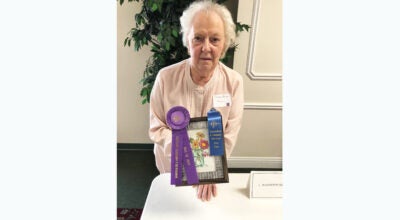Seniors hoping voters show support
Published 12:00 am Sunday, November 6, 2011
SOUTH POINT — It was barely 11 a.m. Friday the third week of October and the cool temperatures through the night had brought more leaves down along Sandusky Road.
It was a dreary day with a dampness that makes bones ache, the kind of day that a meal of comfort food can turn right.
Down the driveway to a brick ranch house where lace curtains hung delicately and a dime store scarecrow was stuck in a flower bed, Meals on Wheels driver Lenny Rice steered his white CAO van. As he got out, he got a glimpse of Eileen Smith peeking out of her kitchen door by the carport waiting.
“There she is,” Rice called out and grabbed a Styrofoam container from the back of the van.
“Let me see how good it looks,” Smith said and invited Rice into her kitchen.
Today’s menu was a turkey dinner that Rice, along with the other drivers, helped chef Larry Utley dish up only a few minutes earlier.
“I was in the hospital in July and I’m not able to stand and cook. I’m on oxygen,” Smith said, on why she depends on the Ironton-Lawrence County CAO’s Meals on Wheels program.
“I really rely on them,” she said. “They are good, balanced meals.”
Back in the van, Rice headed down the road. In a couple of hours he will have delivered more than 100 meals, racking up almost as many miles on the van.
It’s a job he delights in.
“We drive to where there are people,” he said.
Needing to restock, Rice stopped back at the Sybene Senior Center, where Utley had started at 5 that morning roasting 10 turkey breasts, tearing up loaves of bread for stuffing and steaming a hodgepodge of vegetables. There he loaded up with more meals.
“These are nutritional meals,” Chris Schneider, supervisor of the meal delivery, said. “It gives someone a hot meal for lunch and there’s a frozen meal, home-cooked. It’s microwaveable, so you have variety.”
A thousand meals go out each week to seniors across the county with drivers logging up to 300 miles a day on three routes. The Sybene kitchen also provides the meals for the two senior centers’ daily lunch meal.
“First you have to be 60 years and have a need,” Schneider said. “They’ve got to be where they can’t cook for themselves and need a hot meal.”
The age rule may say 60, but the lion’s share of those who call on Meals on Wheels are 80 years or older, Schneider says.
Last year more than 50,000 home meals were delivered, on top of the 15,000 meals taken to the two senior sites. CAO vans also made more than 4,000 medical trips that year among its age-specific services.
And it’s those seniors that the CAO says could lose services because of state and federal cuts. In fact, in 2010 state cuts to traditional senior programs reached 39 percent.
Offsetting that is among the reasons why the CAO wants a 1-mill senior levy on this Tuesday’s ballot passed. The levy would bring in $800,000 a year.
Besides balancing out cuts, the CAO says it wants to do more for more senior citizens, especially those in the rural parts of the county. Pinpointing those services was the responsibility of a 14-member oversight and advisory committee.
Since May members of the committee and those associated with the CAO have been on an informal talk circuit promoting the levy and what it can do for the county.
Among those services are adding more medical and critical services, transportation for homebound, especially those on waiting lists; adding more clients to the Meals on Wheels and the senior center lunches; expanding home health services; and creating an emergency home repair fund that would fund handicapped ramps and comparable aids so seniors can stay in their homes.
However, providing these services and more comes with a price. It’s a price to organizations like the CAO that offers them and a price to the taxpayers who are the ultimate suppliers of the services.
According to the county auditor’s office, the proposed senior levy would cost a taxpayer approximately $35 a year on a house with the marketable value of $100,000.
That breaks down to just under $3 monthly. For a home worth $75,000 those figures go down to $26.25 annually or $2.19 a month.
Yet of the 39 taxing districts in the county most already have some form of levy on the property owners.
For example, in Ironton a property valued at approximately $120,000 has taxes just under $1,000 for the year. That includes 8.2 mils on an $18 million bond for city schools that costs about $100 annually. The senior levy would add an additional $32.
In Proctorville, a property with a comparable value has taxes of approximately $950 annually. That includes 2.5 mills for the street levy that costs the homeowner $42.20 a year; the 1.5 fire department levy at $24.35 a year and a $4 million school bond at $15.79. The senior levy would add $36.36 annually.
In Chesapeake a property with a marketable value of $84,000 has taxes of just over $580 a year, including 1 mil on a $2.4 million school bond costing the taxpayer $8.93. The senior levy would add $25.52 to that bill.
Yet one member of the levy’s advisory board says how one votes on the levy depends on what one wants for his home community.
“I have always supported school levies, what is good for our youth,” Carol Allen, longtime community activist, said. “And our population is weighted toward the elderly in Lawrence County. I do not think we can discount them because they are no longer working. If anyone has any experience with a relative or close friend who has been on short-term or long-term care, you need outside services. And they are not readily available.”
What appeals to Allen is that the services are related to a senior’s need, not the amount of money made in the past or currently coming in.
“I personally think we have a responsibility to both the young and old,” she said. “Neither group has the means to take care of themselves. It is very difficult to get something like this passed, but I feel it is an important responsibility and it will make our community a better place.”





